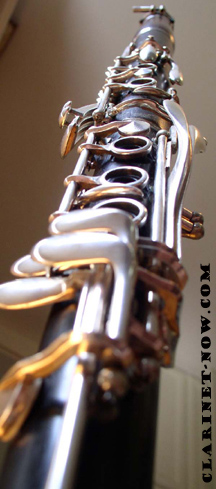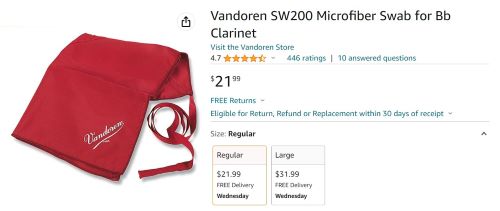Clarinet Swab
Clarinet Swab Topics on this page include
1. Why you use a swab?
2. Proper swab use
3. Tip on drying the mouthpiece
4. Tip on laundering the swab
5. Why launder the swab?
6. Best swabs
If your Clarinet Swab is Stuck in the Clarinet, read here.
WHY YOU USE A SWAB?
You may have noticed already that during your clarinet practicing or at the end, when you take it apart, there is water in the bore and often in the keys.
This water is more a result of condensation rather than spit. Remember your Geography class when warm air meets cold air? Your warm humid lung air blows into the clarinet and meets the cooler air in and around the clarinet. Once that warm humid air reaches the cooler air, the humidity condenses all of the H20 molecules in the air and the collection is liquid water. This is the same as if a small cold front takes over warmer air – you get liquid rain, right?
Water builds up in the clarinet bore and often runs into the keys or creates gurgle sounds while blowing. It is not spit, unless your embouchure is really incorrect or very tired (either can cause drool). In order to keep the water from running into the key holes, you swab the clarinet out to dry out the bore.
CYBER MONDAY 2025 CLARINET DEALS
Get 5% off a CLARINET, MOUTHPIECES, REEDS OR EVEN NEW MUSIC CAREER TRAINING
This is a special Clarinet-Now.com code for a limited time: CHRISTOPHERJONE
TIPS ON PROPER CLARINET SWAB USE
(AVOID GETTING THE SWAB STUCK)
 Clarinet Tower
Clarinet TowerClarinet maintenance comes best with proper clarinet care. You have to dry your instrument out with a clarinet swab, so doing this while preventing the swab from getting stuck is very important. This is what I do.
1. Take the clarinet barrel and mouthpiece off (as a unit).
2. Turn clarinet upside down and put the weight of swab into the bell.
3. Make sure you have no knots in string or swab.
4. Slowly let the weight through clarinet until it comes out of the top.
5. Before you pull the swab through, make sure the cloth is not bunched up but spread out.
6. Slowly pull swab through top of clarinet.Some folks keep the barrel on the clarinet and remove only the mouthpiece. I’ll tap my barrel and mouthpiece combination on my knee to drive out the condensation. AND, CONDENSATION IT IS. Not spit (if you are playing correctly).
Clarinet silk swabs work best to avoid getting stuck in the bore of the clarinet.
TIP ABOUT DRYING MOUTHPIECE WITH THE CLARINET SWAB
Another tip, if you do dry out your mouthpiece with the clarinet swab. Take extra care and don’t just shove the weight through the mouthpiece. Especially a metal weight (not covered with cloth or rubber), can scratch the tip of the mouthpiece.
Why does this matter? A thousandth of an inch off the tip of the mouthpiece can really change its sound and/or response.
TIP ABOUT CARE OF RUBBER WEIGHT OR SEWN
CLOTH WEIGHT ON CLARINET SWABS
Another swab tip especially for swabs with rubber coated or cloth covered weights. You can wash them in the washing machine (make sure it does not get coiled in the agitator), but do not put it in the dryer on the hottest setting.
I’ve ruined many swabs by drying them in a dryer on hot. The rubber will melt off of the weight or the metal will burn through the cloth and the swab will render useless without the weight.
Either hang the swab out to dry, or use a much cooler setting while drying in the dryer.
TIP ABOUT CLEANING THE CLARINET SWAB
It is very important to wash your clarinet swab. This is what happens if you do not. The swab gets gunked-up with some food particles and/or coffee or hot chocolate remnants, extraneous cork grease that finds its way into the bore of the clarinet catches on the swab, and sometimes (after you’ve placed the swab on the floor next to your chair) just plain dirt gets in there.
Combine water, grease, dirt, etc…, drag it through the bore of a clarinet, and its numerous tone holes will collect some of that gunk. Once this build up occurs, the tone holes reduce in size due to the build-up causing a flatter or smaller sound from certain notes.
So, in reading the two above tips:
Do wash your swab in the washing machineAvoid getting the string or swab stuck in the agitator of the washer.
Remember to take the swab out of the washer and hang to dry (if you put this in the dryer, use a cooler setting so the weight does not melt out of the rubber coating or burn out of the sewn cloth covering).
OTHER CLARINET DRYING AND CLEANING ASSESSORIES Cigarette paper – use this thin paper to place between the pads and tone holes of the clarinet. Doing this will soak up the condensation bubbles or gurgles that often form in the tone holes. Read this page to avoid getting your swab stuck in the future.


